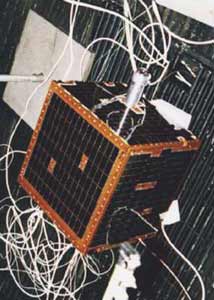Thank you very much for visiting Gunter's Space Page. I hope that this site is useful and informative for you.
If you appreciate the information provided on this site, please consider supporting my work by making a simple and secure donation via PayPal. Please help to run the website and keep everything free of charge. Thank you very much.
SEDSat 1 (SO 33, SEDSat-OSCAR 33)

SEDSat [NASA]
SEDSat 1 (Students for the Exploration & Development of Space - Satellite) is an american microsatellite. It was to obtain images of the Earth and distribute them through the Internet from the University of Alabama in Huntsville. It also served as a relay for amateur radio communications.
The 34 kg satellite was built on a 32.13 cm × 32.13 cm × 35.43 cm structure. Originally it was to be deployed via a SEDS tether system (similar to SEDS 1, 2) from the Shuttle under the name SEDS-3, but due to concerns with using the tether system with the Shuttle, the mission was first redesigned for a tetherless deployment from the Shuttle and then for a deployment from a Delta stage 2.
SEDSat featured following equipment:
- Imaging camera (SEDS Earth Atmospheric and Space Imaging System [SEASIS],) Visible light camera with 10, 7 and 10 nanometer filters for measuring atmospheric extinction coefficients. Resolution was 60 m in telephoto mode and 10 km in panorama mode.
- Mode L (13 cm uplink, 70 cm downlink digital packet UoSat compatible)
- Mode A (2 meter uplink, 10 meter downlink, analog SSB 70 Khz transponder)
SEDSat 1 was launched as a piggy back payload mounted on stage 2 of a three stage Delta-7326 launch vehicle, which sent the Deep Space 1 (DS 1) space probe into a solar orbit. SEDSat 1 suffered from problems in the power system, causing both the imaging payloads and the amateur radio transponders never becoming operational. Only some telemetry was received. It was designed with a lifetime of five years, but was still semi operational in 2013.
| Nation: | USA |
|---|---|
| Type / Application: | Technology |
| Operator: | SEDS |
| Contractors: | SEDS |
| Equipment: | SEASIS |
| Configuration: | 32.13 cm × 32.13 cm × 35.43 cm structure |
| Propulsion: | ? |
| Power: | Solar cells, batteries |
| Lifetime: | 5 years (design) |
| Mass: | 34 kg |
| Orbit: | 547 km × 1079 km, 31.4° |
| Satellite | COSPAR | Date | LS | Launch Vehicle | Remarks | |
|---|---|---|---|---|---|---|
| SEDSat (SO 33, SEDSat-OSCAR 33) | 1998-061B | 24.10.1998 | CC SLC-17A | Delta-7326 | with DS 1 |
References:
- NSSDC Master Catalog: SEDSAT 1
